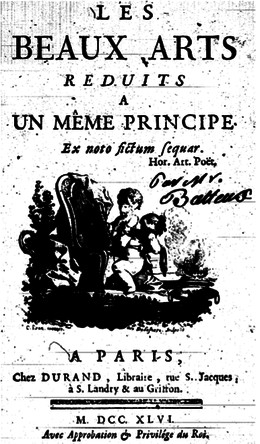Charles Batteux
Charles Batteux, called Abbé Charles (* May 6, 1713 in Alland'Huy at Vouziers, Ardennes, † July 14, 1780 in Paris) was a French aestheticians.
Life and work
After completing his schooling at the University of Reims Batteux began to study theology. With the completion of this study, he was appointed canon of the cathedral of Reims. As such, he was appointed professor at the Collège de Lisieux (Paris).
As " Professor of rhetoric and humanities " was entrusted Batteux 1750 as a lecturer at the Collège Royal ( Paris); later he taught " Greek and Roman philosophy."
1754 Batteux member of the Académie des Inscriptions et Belles Lettres and in 1761 he was admitted as a successor of Odet -Joseph Giry ( 1699-1761 ) to the Académie française ( fauteuil 31).
Reception
As the founder of a new French art philosophy Batteux looked principles of French classicism overcome. Artists should not be based his opinion on the art, but to nature. You should not replicate the classic works in the first place, but the real life (and thus also about the creaturely expressions of the people who were frowned upon in classical).
This view is justified by Batteux its interpretation of the Poetics of Aristotle: " Imitate the nature ". This Batteux paved the way for many artists and intellectuals who wanted to break away from the authoritarian conceptions of French absolutism, led by Jean -Jacques Rousseau, with his motto " Back to nature".
With his work Les beaux -arts réduits à un même principe ( The Fine Arts traced back to a single principle, 1747 ), he tried to make the imitation of nature to a common basic principle of all the arts. This caused him to literature and even more so for the music some difficulties, but it convinced many contemporaries.
A lot of buzz among French and German art theorists caught the Cours de belles lettres font ou principes de la littérature after the Epistola ad Pisones of Horace. The of the Count of Saint- Germain commissioned and together with Étienne- Maurice Chompre, Jean Ferdinand Monchablon and Philippe de Prétot jointly verfertigte processing of the Cours d' études à l' usage de l' École royale of élèves militaire in 45 volumes a compilation.
Works
- Cours d' études à l' usage de l'Ecole royale of élèves militaire. Paris 1751 (45 vols, together with Pierre Chompre, Jean Ferdinand Montchablon and Philippe de Prétot ).
- Limitations of the fine arts to a single principle ( " Les beaux -arts réduits à un même principe "). Weidmann & Reich, Leipzig 1770 ( translation by Johann Adolf Schlegel ).
- History of Meynungen the philosophers of the first root causes of things ( " Histoire des Causes Premieres "). Halberstadt in 1792 ( 2 vols, translated by Johann Jakob Engel ).
- Mémoires concernant l' histoire, les sciences, les arts, les moeurs et les usages of the Chinois. Paris 1776-1789 ( 15 volumes, together with Louis Joseph de Guignes and Georges Bréquigny ).
- Belles lettres Cours de ou principes de la littérature. Paris 1747-50 (5 vols, translated by Karl Wilhelm PeterRamler as an introduction to the fine arts, Leipzig 1756-58 ( digitized version of the 3rd edition 1769 PDF: Vol 1, Vol 2, Vol 3, Vol 4 ) ).
- The morality of Epicurus ( " La morale d' Epicure "). Halberstadt 1792 ( translation by Johann Gottfried Bremer).
- Les poésies de Horace. Paris 1768 ( 2 vols ).
- Lettres sur la phrase avec la française comparée latine. 1748







